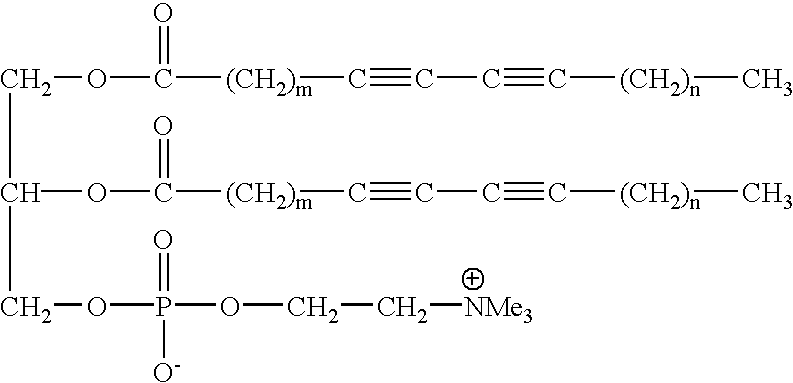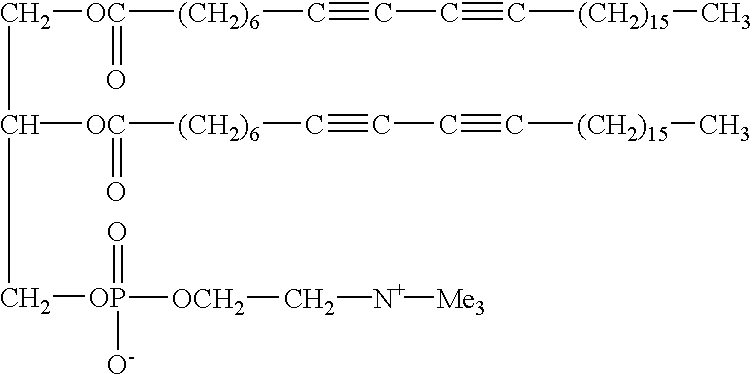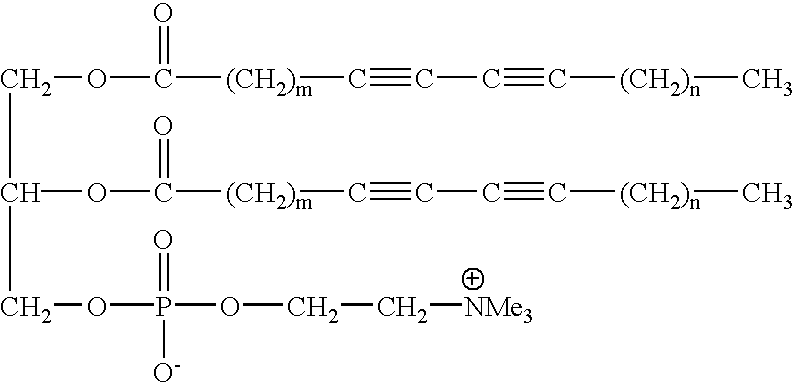Method, detector, and apparatus for colorimetric detection of chemical and biological agents
a colorimetric and biological agent technology, applied in the direction of chemical methods analysis, instruments, chemical indicators, etc., can solve the problems of difficult thin film making, ineffective polymerization of diacetylene moiety in a small vesicle, and insufficient spectrophotometric reading of the film, etc., to achieve effective polymerization and large radius of curvature
- Summary
- Abstract
- Description
- Claims
- Application Information
AI Technical Summary
Benefits of technology
Problems solved by technology
Method used
Image
Examples
example 2
This example illustrates the stability of the GUV on cooling and demonstrates GUVs can be cooled down to about 28.degree. C. below their T.sub.m without losing their morphology. This permits production of longer conjugation and consequently good color.
GUVs as made in Example 1 from DC.sub.6,15 PC upon slow-cooling below their T.sub.m did not show any morphology transformation. They remained as bubbles and did not become tubules, smaller vesicles or simply flat sheets. The effect of cooling on the morphology was studied by using optical microscopy. The swelling cell, which is the container in which GUVs are created, produces many giant vesicles with diameters up to about 300 micrometers, was directly placed in a temperature regulated support connected to a thermostated bath. The temperature changes were monitored by a microcomputer thermometer. The thermocouple was inserted between the cell and the regulated heating support, which provided accurate readings of the cell temperature. G...
example 3
This is a comparative example illustrating the effect of cooling on saturated 1,2 distearoyl phosphatidylcholine (DSPC).
Saturated 1,2 distearoyl phophatidylcholine (DSPC) having the formula: ##STR4##
was cooled from 60.0.degree. C. to 42.0.degree. C. and rate of cooling was 1.degree. C. / min. The liquid to gel phase transition temperature T.sub.m occurred at 47.8.degree. C.
This example illustrates the difference between diacetylenic GUVs as evaluated in Example 2 and DSPC GUVs and it illustrates the uniqueness of a GUV derived from a diacetylenic lipid. Saturated DSPC GUVs don't shrunk in size upon cooling so they are stable, but they have no color. The reason for this is that upon polymerization diacetylene produces deep blue to red color showing that diacetylenes are polymerized to conjugated polydiacetylene. The DSPC, on the other hand, does not polymerize because it doesn't have any diacetylene functionality. The diacetylenic GUVs do not gel like saturated DSPC GUVs and they are n...
example 4
This example illustrates that GUVs do not change morphology upon cooling
Polymerization of GUVs of DC.sub.6,15 PC was performed by directly irradiating a sample cell with UV light from a mercury pen lamp. The temperature was maintained at 50.degree. C., well below T.sub.m (59.degree. C.), so the lipid would be in its low temperature ordered phase. In this phase the acyl chains will be in the all-trans configuration, with their diacetylenic units packed close together, which is the favorable alignment required for topotactic polymerization. As the polymerization progressed, the contrast of the GUV in the optical images began to decrease. After about 30 seconds had passed, the contrast had dropped substantially, and the GUV had become very difficult to distinguish from the surrounding medium. The initial high contrast was because inside the vesicle the contents are differe...
PUM
| Property | Measurement | Unit |
|---|---|---|
| size | aaaaa | aaaaa |
| temperatures | aaaaa | aaaaa |
| Tm | aaaaa | aaaaa |
Abstract
Description
Claims
Application Information
 Login to View More
Login to View More - R&D
- Intellectual Property
- Life Sciences
- Materials
- Tech Scout
- Unparalleled Data Quality
- Higher Quality Content
- 60% Fewer Hallucinations
Browse by: Latest US Patents, China's latest patents, Technical Efficacy Thesaurus, Application Domain, Technology Topic, Popular Technical Reports.
© 2025 PatSnap. All rights reserved.Legal|Privacy policy|Modern Slavery Act Transparency Statement|Sitemap|About US| Contact US: help@patsnap.com



